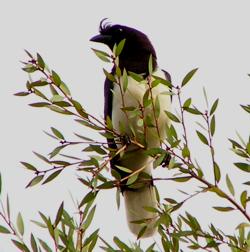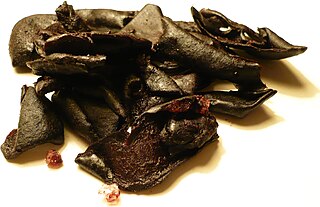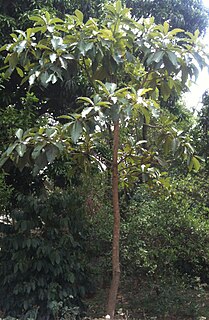
The Xingu River is a 1,640 km (1,019 mi) river in north Brazil. It is a southeast tributary of the Amazon River and one of the largest clearwater rivers in the Amazon basin, accounting for about 5% of its water.

Vegetable oils, or vegetable fats, are fats extracted from seeds, or less often, from other parts of fruits. Like animal fats, vegetable fats are mixtures of triglycerides. Soybean oil, rapeseed oil, and cocoa butter are examples of fats from seeds. Olive oil, palm oil, and rice bran oil are example of fats from other parts of fruits. In common usage, vegetable oil may refer exclusively to vegetable fats which are liquid at room temperature.

Annatto is an orange-red condiment and food coloring derived from the seeds of the achiote tree native to tropical regions from Mexico to Brazil. It is often used to impart a yellow or orange color to foods, but sometimes also for its flavor and aroma. Its scent is described as "slightly peppery with a hint of nutmeg" and flavor as "slightly nutty, sweet and peppery".

Attalea maripa, commonly called maripa palm is a palm native to tropical South America and Trinidad and Tobago. It grows up 35 m (115 ft) tall and can have leaves or fronds 10–12 m (33–39 ft) long. This plant has a yellow edible fruit which is oblong ovoid and cream. An edible oil can be extracted from the pulp of the fruit and from the kernel of the seed.

A pumpkin seed, also known as a pepita, is the edible seed of a pumpkin or certain other cultivars of squash. The seeds are typically flat and asymmetrically oval, has a white outer husk, and is light green in color after the husk is removed. Some cultivars are huskless, and are grown only for their edible seed. The seeds are nutrient- and calorie-rich, with especially high content of fat, protein, dietary fiber, and numerous micronutrients. Pumpkin seed can refer either to the hulled kernel or unhulled whole seed, and most commonly refers to the roasted end product used as a snack.
Buffalo gourd oil is a seed oil, extracted from the seeds of the Cucurbita foetidissima, which is native to southwest North America. As the Latin name of the plant indicates, the vine has a foul smell. The seeds of the Buffalo gourd are rich in oil and protein, and were used by American Indians to make soap. The oil's fatty acid composition is dominated by linoleic acid (64.5%) and oleic acid (17.1%).

The curl-crested jay is a jay from South America.
The Trumai are an indigenous people of Brazil. They currently reside within the Xingu National Park, in the state of Mato Grosso. They have a population of 258 in 2014. They were 97 in 2011 and 120 in 2006, up from a low of 26 in 1966.

The Belo Monte Dam is a hydroelectric dam complex currently under construction on the northern part of the Xingu River in the state of Pará, Brazil. The planned installed capacity of the dam complex would be 11,233 megawatts (MW), which would make it the second largest hydroelectric dam complex in Brazil and fourth largest in the world by installed capacity, behind the Three Gorges Dam and the Xiluodu Dam in China and the Brazilian-Paraguayan Itaipu Dam. Considering the oscillations of flow river, guaranteed minimum capacity generation from the Belo Monte Dam would measure 4,571 MW, 39% of its maximum capacity.

Marula oil is extracted from the kernels (nuts) of the fruits of the Marula trees, from the Anacardiaceae family. There are two types of marula oil, the oil extracted from the seeds and the oil extracted from the nut's hard shell. Marula oil is traditionally used in cosmetics, in food as a cooking oil, and as a meat preservative and to treat leather.

Amazon Watch is a nonprofit organization Founded in 1996, and based in Oakland, California, it works to protect the rainforest and advance the rights of indigenous peoples in the Amazon Basin. It partners with indigenous and environmental organizations in Ecuador, Peru, Colombia and Brazil in campaigns for human rights, corporate accountability and the preservation of the Amazon's ecological systems.

Kuikuro or Kuikuroan is a dialect of the Upper Xingu Language spoken by the Kuikuro people. The Kuikuro are a group of Indigenous people living in Mato Grosso, Brazil. The Upper Xingu Language is part of the Southern branch of the Cariban language family. Although bilingualism in Brazilian Portuguese is prevalent among the men of the community, Kuikuro is not as immediately endangered as many of Brazilian Indigenous languages. As of 2006, there are an estimated 1,106 native speakers of Kuikuro worldwide, yielding the language a "Threatened" classification by The Endangered Languages Project. In collaboration with linguist Bruna Franchetto, the Kuikuro have created a library of recordings that feature Kuikuro stories in the language that is archived at the Archive of the Indigenous Languages of Latin America
Vateria indica oil is extracted from the seeds of the Vateria indica plant, a species in the Dipterocarpaceae family. The Vateria indica plant is indigenous to the Western Ghats, Kerala and Tamil Nadu regions of India. It thrives in the evergreen forests, surviving up to 800 meters above sea level. Oil from the seeds of the plant is extracted through a chemical refining process which makes the plant edible.

Shorea robusta seed oil is an edible oil extracted from the seeds of Shorea robusta. Shorea robusta is known as the Sal tree in India. Sal is indigenous to India and occurs in two main regions separated by the Gangetic Plain, namely the northern and central Indian regions. The plant belongs to the Dipterocarpaceae botanical family.

Kokum oil is a seed oil derived from the seeds of the kokum tree. Kokum oil is edible and can also be used for things other than cooking.

Phulwara oil is extracted from seeds of Phulwara tree. Phulwara Trees are also known locally as Chiuri Trees, Kaeleb Trees, or Butter Nut Trees. Refined Phulwara Oil is marketed as Phulwara Ghee.

Cerradão is a type of dry forest found in Brazil, associated with the cerrado savanna ecoregion.
















